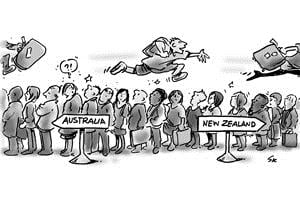Do many Australians move to NZ? This question was posed to the Twitter-sphere recently and thus the topic for my next blog was decided.

The number of New Zealanders moving to Australia is a popular topic, both in public and political discourse, I think it’s high time we looked at the reverse phenomenon, how many Australians move to New Zealand.
Australia and New Zealand have strong ties through migration, trade and political engagement. These ties are supported by agreements which assist in the easy movement of people between the two countries, such as 1973 Trans-Tasman Travel Arrangement which allows Australian and New Zealand citizens to enter each other’s country to visit, live and work, without the need to apply for authority to enter the other country before travelling ( New Zealand Ministry of Foreign Affairs and Trade).
How many Australians moved to New Zealand last year?
The migration statistics prepared by Statistics New Zealand are based on responses to the arrival and departure cards that passengers complete at the airport. Last year nearly 15,755 people arrived to live in New Zealand and reported that their country of last permanent residence was Australia. Many of these migrants are not Australian citizens however, some will have New Zealand or another country’s citizenship and be coming or returning to NZ after spending a year or more in Australia.
The migration data by country of residence and citizenship shows that two-thirds (10,308) of those 15,755 people arriving permanently in New Zealand, after living in Australia for a year or longer, were in fact New Zealand citizens. 3,126 Australian citizens arrived to live in New Zealand permanently, making up just 4.3% of the total number (86,026) of people arriving to live in NZ in the year ending March 2013. So, the short answer to the question would be ‘no, not many Australians move to NZ’.

If you group the data by region of last permanent residence; Oceania, Asia, Europe, Americas, and Africa and the Middle East, then people whose last place of residence was in Asia contributed the largest number and proportion of permanent arrivals (27,094 people or 31%), followed by Oceania (which includes Australia) which contributed 20,016 (23%). It goes to show that how you ‘slice and dice’ the numbers really impacts on how you understand the data.
How about the longer-term trend in Australian arrivals to New Zealand?
This year’s rate of 4.3% of the total number of permanent arrivals is one of the lowest rates over the last 34 years that Statistics New Zealand has collected data for permanent and long term migration by citizenship. The highest number was in 2005 when 5,382 Australian citizens to arrive to live in NZ permanently. In that year Australian citizens made up 6.9% of permanent arrivals to New Zealand, so, still not a huge amount.
Do many Australians leave New Zealand?
In the last year (12-months ending March 2013) 2,757 people with Australian citizenship permanently departed New Zealand after living there for over a year. Taking into account the number of Australian citizens arriving the in the same period (3,715), New Zealand had a net gain of nearly a thousand Australians (958).
Are you an Australian citizen living in New Zealand? Please leave a comment telling us about your migration history and family ties to our neighbouring nations.
Access our online demographic resource centre now to get the latest NZ and Australian population figures!













